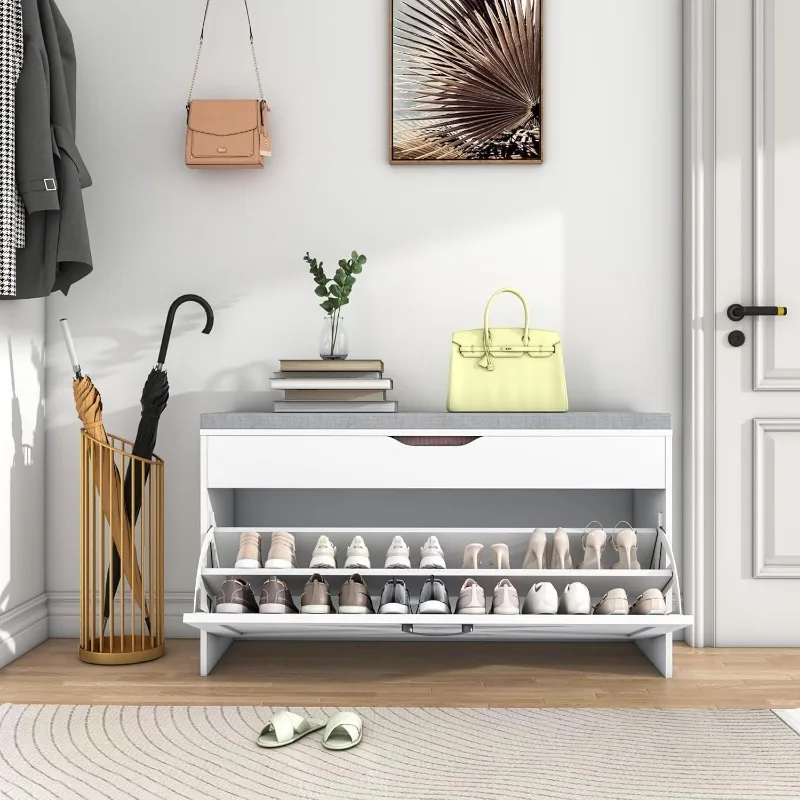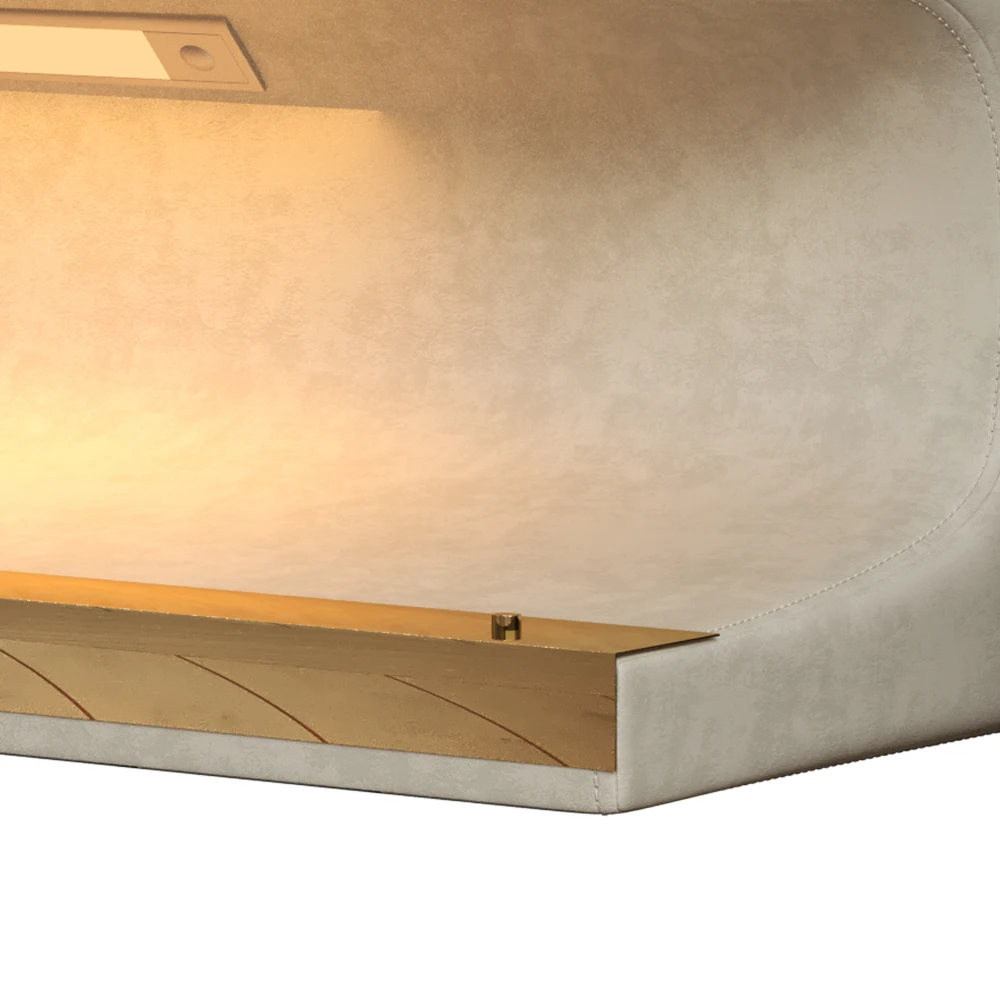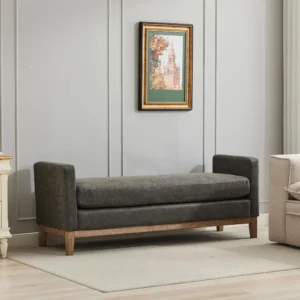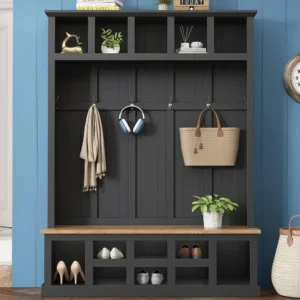Your entryway is more than just a passage into your home—it’s the first chapter in your home’s story. This transitional space sets the tone for the entire experience of your living environment, creating that crucial first impression for both guests and residents alike. A thoughtfully designed entryway strikes the perfect balance between functionality and beauty, turning an ordinary space into one that genuinely welcomes everyone who crosses your threshold.
What makes an entryway truly welcoming? It’s a harmonious blend of practical elements that serve your daily needs and aesthetic touches that reflect your personal style. When designed well, your entryway can reduce daily stress, organize essentials, and create a sense of arrival that psychologically prepares you to either face the world or relax back into your sanctuary.
Design psychology research has long shown that transitional spaces like entryways significantly impact our mood and perception of a space. The way we experience that shift from public to private space can influence how we feel about our entire home.
In this comprehensive guide, we’ll explore how to transform your entryway—whether it’s spacious or compact, modern or traditional—into a beautifully functional space that makes everyone feel instantly at home. From foundational design elements to personal finishing touches, you’ll discover how to create an entrance that’s not just organized but truly inviting. Consider implementing space-saving benches for your entryway to immediately enhance both function and style in this critical area of your home.
I. Essential Elements of a Welcoming Entryway: The Foundation
A. Creating the Perfect Color Story and Style Harmony
The colors you choose for your entryway create an immediate emotional response and set the tone for your entire home. This psychological impact shouldn’t be underestimated—warm neutrals like taupe, soft beige, and greige create calm, while bolder colors like navy or forest green add drama and sophistication.
For a truly welcoming entrance, consider how your entryway colors transition from the exterior to the interior of your home. This transition should feel intentional rather than jarring, guiding visitors smoothly into your living space. The entryway’s style should also serve as a preview of what’s to come in the rest of your home, whether that’s modern minimalist, cozy farmhouse, or eclectic bohemian.
Texture plays an equally important role in creating warmth. Consider these winning combinations:
* Warm wood tones with matte black metal accents
* Natural jute or sisal with reflective glass or mirror
* Soft textiles against smooth painted surfaces
When working with limited square footage, thoughtful space-saving entryway ideas can help you make the most of your color and style choices without overwhelming the space.
B. Strategic Lighting for Welcome and Warmth
Proper lighting transforms an entryway from a mere passageway into an inviting threshold. The most effective entryway lighting plans incorporate three essential layers:
- Ambient lighting: Provides overall illumination (ceiling fixtures, recessed lights)
- Task lighting: Illuminates specific activities like checking mail or finding keys (table lamps)
- Accent lighting: Creates atmosphere and highlights design features (wall sconces, picture lights)
| Lighting Type | Best Applications | Key Benefits |
|---|---|---|
| Pendant Light | Center of foyer, high ceilings | Creates focal point, adds style statement |
| Wall Sconces | Flanking mirror or artwork | Provides flattering, shadow-free lighting |
| Table Lamp | On console table or side table | Adds warm, adjustable light source |
| Recessed Lighting | Throughout entryway | Delivers clean, unobtrusive illumination |
Don’t overlook natural light—keep window treatments minimal or use sheer fabrics that filter light without blocking it. Strategically placed mirrors can amplify available daylight, making the space feel brighter and more expansive.
For a truly inviting space, pair your lighting with comfortable seating like our entryway bench cushions that complement your lighting scheme while adding practical comfort.
C. Flooring Solutions: The Foundation of Welcome
Your entryway floor endures more traffic and abuse than perhaps any other surface in your home. The right flooring not only withstands these demands but also makes a strong style statement.
Consider these popular entryway flooring options:
- Porcelain or ceramic tile: Extremely durable, water-resistant, and available in countless styles
- Engineered hardwood: Offers the warmth of wood with better moisture resistance
- Natural stone: Provides timeless elegance and exceptional durability
- Luxury vinyl planks: Budget-friendly, waterproof, and now available in remarkably realistic designs
The humble doormat serves as both your home’s first line of defense against dirt and moisture and its first greeting to visitors. Choose one that’s appropriately sized for your doorway and reflects your home’s personality while being sturdy enough to handle heavy use.
When adding an area rug, ensure it’s sized appropriately for your space—too small and it will look awkward, too large and it might impede door function. Look for durable, stain-resistant materials like wool blends, polypropylene, or indoor/outdoor options that can handle heavy foot traffic.
For those who prefer streamlined organization systems, minimalist entryway organization approaches can help keep your floors clear and your space more welcoming.
D. Designing for Flow and Accessibility
A truly welcoming entryway invites people in rather than creating obstacles. Good flow means having clear, unobstructed pathways that allow for comfortable movement—generally at least 36 inches wide for main walkways.
Key principles for optimal entryway flow:
* Create direct paths to frequently used doorways
* Avoid furniture arrangements that create bottlenecks
* Ensure doors can open fully without obstruction
* Consider the natural movement patterns of household members
Universal design principles can make your entryway more welcoming to everyone, regardless of age or ability. Consider elements like adequate lighting, non-slip flooring, and transitions without level changes where possible. If steps are necessary, ensure they’re well-marked and include sturdy handrails.
For oddly shaped or narrow entryways, corner entryway benches can dramatically improve traffic flow while maximizing your available space.
II. Functional Furnishings: Balancing Style with Practicality
A. The Perfect Console Table: Your Entryway Command Center
A well-chosen console table serves as the command center of your entryway, providing both a functional landing zone for everyday essentials and a style statement that sets the tone for your home. When selecting the right console, proportion is key—typically, these pieces should stand 30-36 inches tall, be 30-48 inches wide (depending on your wall space), and 12-15 inches deep to allow for easy passage.
To create a truly functional “drop zone” that prevents clutter from migrating further into your home:
- Include a designated spot for mail and papers
- Provide a small dish or tray for keys and pocket items
- Consider a charging station for phones and devices
- Add hooks or small baskets for items that need to be grabbed on the way out
Style your console table in layers, with taller items at the back (lamps, artwork) and smaller objects in front. The rule of three works well here—group items in odd numbers for visual interest.
For those with extremely limited space, wall-mounted floating shelves or narrow cabinets can provide similar functionality without protruding too far into the walkway. Combining different furniture pieces can maximize functionality in tight spaces—consider how small entryway benches might pair with your console for both seating and surface area.
B. Comfortable and Practical Seating Options
Incorporating seating in your entryway isn’t just about comfort—it’s about practicality. Having a place to sit makes everyday tasks like putting on shoes, sorting mail, or waiting for family members significantly more convenient.
Different seating options offer unique advantages:
- Benches: Provide the most seating capacity and often include storage
- Ottomans: Offer flexibility, as they can be moved around easily
- Accent chairs: Add a more formal, living room-like feel
- Stools: Take up minimal visual space while still providing a place to perch
When space allows, dual-purpose seating with built-in storage is particularly valuable in entryways. These pieces help contain seasonal items like hats and gloves while offering a comfortable spot to sit.
For proper placement, ensure at least 24 inches of clearance in front of any seating to allow for comfortable use without blocking traffic flow. In narrow entryways, consider a slimmer bench (12-15 inches deep) placed against the wall to maintain adequate passageway.

For maximum functionality in minimal space, explore our entryway bench storage options that seamlessly blend seating and organization.
C. Smart Storage Solutions to Conquer Entryway Clutter
Even the most beautifully designed entryway will feel unwelcoming if it’s overwhelmed with clutter. Effective storage solutions are essential for maintaining order in this high-traffic zone.
For coat and bag storage:
* Wall-mounted hook systems offer accessibility without taking up floor space
* Hall trees combine multiple storage functions in one piece
* Over-door hooks utilize often overlooked space
* Slim coat closets with organized interiors maximize vertical storage
For shoe organization:
* Dedicated shoe benches keep footwear contained while offering seating
* Cabinets with tilted shelves display shoes while keeping them dust-free
* Open cubbies allow air circulation for wet shoes
* Boot trays protect flooring from moisture and dirt
For mail and small items:
* Wall-mounted sorters keep paperwork visible but organized
* Small drawers conceal items that might look cluttered
* Decorative baskets or bins corral miscellaneous items by category
When vertical space is your most abundant resource, think upward with tall, narrow storage pieces or wall-mounted options that leave floor space open. The key to maintaining an organized entryway is creating simple systems that family members will actually use daily.
For families with multiple members and hectic schedules, targeted solutions can help organize busy entryways and bring order to the daily commotion.
Entryway Bench with Cushion, Mudroom Bench with Cushion, Shoe Bench for Entryway
$1,186.63 Select options This product has multiple variants. The options may be chosen on the product pageCoat Rack Shoe Bench, Corner Entryway Bench, Corner Hall Tree, Shoe Bench for Entryway
$313.58 Select options This product has multiple variants. The options may be chosen on the product pageEntryway Bench with Back, Modern Entryway Bench, Shoe Bench for Entryway
Price range: $463.13 through $474.44 Select options This product has multiple variants. The options may be chosen on the product pageCorner Entryway Bench, Entryway Bench with Cushion, Modern Entryway Bench, Shoe Bench for Entryway
$476.34 Select options This product has multiple variants. The options may be chosen on the product pageBench with Hooks and Storage, Entryway Hall Tree, Mudroom Bench with Cubbies, Mudroom Bench with Shoe Storage
$818.38 Select options This product has multiple variants. The options may be chosen on the product pageModern Entryway Bench, Wood Entryway Bench, Wood Mudroom Bench
$497.69 Select options This product has multiple variants. The options may be chosen on the product page
III. Personal Touches: Style Elements That Create Welcome
A. Mirror Magic: Expanding Space and Light
Mirrors are perhaps the most hardworking decorative elements in entryway design, serving multiple practical purposes while enhancing aesthetics. Beyond their obvious function for last-minute appearance checks, mirrors visually expand tight spaces and amplify available light.
For maximum light reflection, position your mirror where it can capture and bounce natural or artificial light. Placing a mirror opposite a window or light fixture dramatically increases the brightness of your entryway.
When selecting a mirror for your entryway, consider these placement tips:
* Position the mirror at eye level for most household members
* Allow at least 2 inches of wall space around the mirror for visual breathing room
* For narrow hallway entryways, choose a vertical mirror to enhance ceiling height
* In larger foyers, a substantial round or square mirror creates a focal point
The mirror’s frame contributes significantly to your entryway’s style story—ornate gold frames add traditional elegance, while clean-lined black frames complement modern spaces. For small entryways, pairing mirrors with appropriately scaled small benches for entryways creates a perfectly proportioned welcome area.
B. Wall Decor That Tells Your Story
Your entryway walls offer prime real estate for expressing personality and setting a welcoming tone. Thoughtfully chosen artwork, photographs, or collections make this transitional space feel intentional and lived-in rather than merely functional.
When creating a gallery wall in your entryway:
* Use a cohesive element (similar frames, color palette, or theme) to unify diverse pieces
* Plan the arrangement on the floor first before hanging
* Consider the view from multiple angles—what will visitors see when entering or leaving?
* Start with a central anchor piece and build outward
For proper scale, wall art should generally occupy about 2/3 to 3/4 of the available wall space above furniture. In entryways with high ceilings, vertical arrangements draw the eye upward and highlight architectural features.
Choose art that makes you happy and reflects your home’s overall aesthetic—this is your opportunity to set the tone for what’s to come in the rest of your home. For contemporary spaces, our modern entryway benches pair beautifully with bold graphic prints or minimalist photography.
C. Living Elements: Plants and Natural Materials
Incorporating plants and natural materials into your entryway creates an immediate connection to the outdoors and brings vital life energy to your threshold space. Research consistently shows that natural elements reduce stress and increase feelings of well-being—exactly the welcome you want to create.
Excellent low-maintenance plants for entryways include:
* Snake plants (Sansevieria) – tolerate low light and infrequent watering
* ZZ plants – virtually indestructible with glossy, architectural foliage
* Pothos – trailing vines that adapt to various light conditions
* Cast iron plants – survive neglect and low light beautifully
* Succulents – perfect for bright entryways with minimal care needs
Creative display options include wall-mounted planters that save floor space, plant stands of varying heights for visual interest, or a statement floor plant in a decorative container that complements your style.
If plant care isn’t your strength, incorporate other natural elements like wooden bowls, stone objects, or dried botanical arrangements that bring texture and organic shapes without requiring maintenance.

The warm character of farmhouse entryway benches pairs perfectly with natural wood elements and greenery to create a cozy, inviting atmosphere.
D. Multi-Sensory Welcome: Beyond the Visual
A truly memorable welcome engages all the senses, not just sight. By thoughtfully addressing sound, scent, and touch, you create a fully immersive experience that makes coming home special every time.
For a sensory-rich entryway:
Scent:
* Reed diffusers offer consistent fragrance without flames or electricity
* Scented candles create both aromatic welcome and warm light
* Seasonal natural elements like cinnamon sticks or fresh evergreens bring timely fragrance
* Keep scents subtle—aim for a hint rather than overwhelming intensity
Touch:
* Incorporate varied textures through textiles, natural materials, and contrasting surfaces
* Add softness with a plush rug, comfortable bench cushion, or textured throw
* Consider temperature—address drafty entryways with rugs and door seals
* Include both smooth and textured elements for sensory contrast
Sound:
* Consider a small fountain for gentle, calming water sounds
* Wind chimes near the entry (inside or outside) create musical welcome
* Ensure solid construction that minimizes creaks and echoes
* Sound-absorbing elements like rugs and textiles reduce harsh acoustics
Creating a complete multisensory experience enhances the psychological transition from outside to inside. Our entryway hall trees form the perfect foundation for building a rich sensory environment by combining multiple functional elements in one cohesive piece.
IV. Solutions for Common Entryway Challenges
A. Small Space Strategies: Maximizing Minimal Entryways
Limited square footage doesn’t mean limited style or function. With strategic planning, even the smallest entryway can deliver a warm welcome while meeting practical needs.
For tiny entryways, focus on these space-maximizing strategies:
* Choose floating or wall-mounted pieces that keep floor space open
* Utilize vertical space with tall, narrow storage solutions
* Select furniture with exposed legs that allows sight lines underneath
* Incorporate pieces that serve multiple functions (seating with storage, mirror with hooks)
* Limit your color palette to create visual cohesion and reduce visual clutter
Visual expansion tricks include using lighter colors on walls, incorporating reflective surfaces like mirrors and glass, and choosing scaled-down furniture with clean lines. Proper lighting is particularly crucial in small spaces—adequate brightness prevents the area from feeling cramped or cave-like.
When every inch matters, smart entryway benches for small spaces can provide essential functionality without overwhelming your limited area.

B. Creating Definition in Open Floor Plans
Open-concept homes present the opposite challenge—how do you create a defined entryway when there are no walls to enclose the space? The goal is to establish a visual boundary that signals “entryway” without disrupting the open feel.
Effective strategies for defining open-concept entryways include:
* Using area rugs to create a distinct floor zone
* Positioning furniture to create implied boundaries
* Installing a partial wall, decorative screen, or bookcases as room dividers
* Creating ceiling definition with pendant lighting or a different paint treatment
* Using color to visually separate the entry from adjacent spaces
Furniture placement is particularly important—try positioning a console table or bench with its back to the living area, creating a natural divider that works from both sides. Storage pieces with drawers are particularly valuable in open layouts where organization is visible from multiple areas. Entryway benches with drawers provide discreet storage while helping establish boundaries in flowing floor plans.
C. Budget-Friendly Transformation Ideas
Creating a welcoming entryway doesn’t require a significant investment. Some of the most impactful improvements can be achieved with minimal expense and a bit of creativity.
High-impact, low-cost entryway enhancements:
* Fresh paint in a welcoming color (cost: $25-50 for quality paint)
* New hardware on existing storage pieces (cost: $3-15 per knob/handle)
* DIY artwork using frames from thrift stores (cost: $5-20)
* Upgraded lighting with new shades or fixtures (cost: $20-75)
* Basket organization system for existing shelving (cost: $15-40)
* Mirror addition for light and visual expansion (cost: $30-100)
* Indoor/outdoor rug for color and texture (cost: $20-80)
DIY projects like creating a custom coat hook wall, repurposing an old dresser as an entry console, or making your own bench cushion can add personal style while stretching your budget. Thrift stores, yard sales, and online marketplaces are excellent sources for entryway furniture that can be refreshed with paint or new hardware.
When working with limited funds, focus on the elements that make the biggest visual impact first. Often, this means addressing the largest surfaces (walls and floors) before moving on to smaller details. For quality pieces that won’t break the bank, explore our affordable entryway bench solutions that combine value with style.
Conclusion
A truly welcoming entryway combines thoughtful design with practical functionality to create a space that makes coming home a joy. By addressing the foundation elements of color, lighting, flooring, and flow, then adding the right functional furnishings and personal touches, you can transform even the most challenging entry space into an area that sets a positive tone for your entire home.
Remember that your entryway should reflect your unique personality and meet your specific household needs. The most welcoming entrances aren’t those that follow design rules perfectly, but those that authentically represent the people who live there while making daily life smoother and more organized.
Start small with changes that make the biggest impact for your situation, and continue evolving your space as needs change. Whether it’s adding a mirror to brighten a dark hallway, incorporating storage to tame everyday clutter, or simply bringing in a plant to add life, each thoughtful addition contributes to creating that perfect welcome that says “you’re home.”







